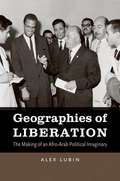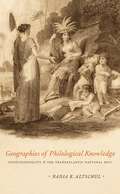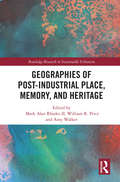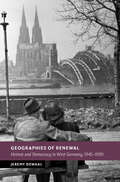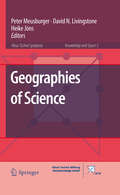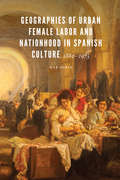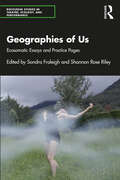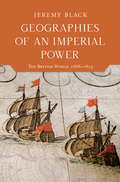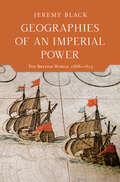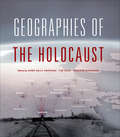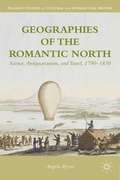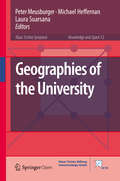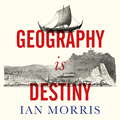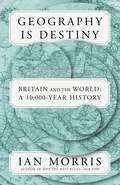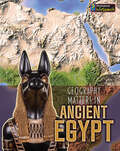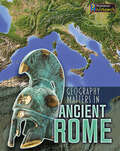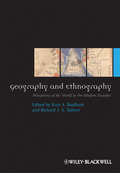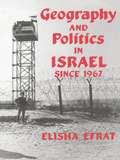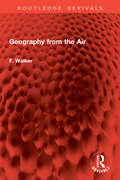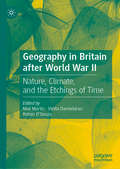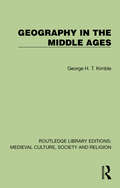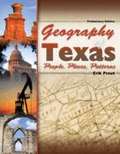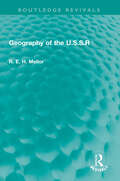- Table View
- List View
Geographies of Liberation
by Alex LubinIn this absorbing transnational history, Alex Lubin reveals the vital connections between African American political thought and the people and nations of the Middle East. Spanning the 1850s through the present, and set against a backdrop of major political and cultural shifts around the world, the book demonstrates how international geopolitics, including the ascendance of liberal internationalism, established the conditions within which blacks imagined their freedom and, conversely, the ways in which various Middle Eastern groups have understood and used the African American freedom struggle to shape their own political movements. Lubin extends the framework of the black freedom struggle beyond the familiar geographies of the Atlantic world and sheds new light on the linked political, social, and intellectual imaginings of African Americans, Palestinians, Arabs, and Israeli Jews. This history of intellectual exchange, Lubin argues, has forged political connections that extend beyond national and racial boundaries.
Geographies of Mediterranean Europe (Springer Geography)
by Rubén Camilo Lois-GonzálezThis edited volume highlights the geographies of six European Mediterranean countries: France, Spain, Italy, Portugal, Turkey and Greece. The book provides a balanced overview on what the geographers of these six countries have investigated and reflected in recent decades. This thematically arranged book takes into account the national differences of the authors, but also highlights the main contributions of Mediterranean geographies on a global scale. It reinforces a perception of common problems and debates in Southern Europe. This book appeals to the institutionalized geographical community of Mediterranean countries but also to a global audience of scholars of geography, territorial and spatial studies, social sciences and history.
Geographies of Philological Knowledge: Postcoloniality and the Transatlantic National Epic
by Nadia R. AltschulGeographies of Philological Knowledge examines the relationship between medievalism and colonialism in the nineteenth-century Hispanic American context through the striking case of the Creole Andrés Bello (1781-1865), a Venezuelan grammarian, editor, legal scholar, and politician, and his lifelong philological work on the medieval heroic narrative that would later become Spain's national epic, the Poem of the Cid. Nadia R. Altschul combs Bello's study of the poem and finds throughout it evidence of a "coloniality of knowledge. " Altschul reveals how, during the nineteenth century, the framework for philological scholarship established in and for core European nations--France, England, and especially Germany--was exported to Spain and Hispanic America as the proper way of doing medieval studies. She argues that the global designs of European philological scholarship are conspicuous in the domain of disciplinary historiography, especially when examining the local history of a Creole Hispanic American like Bello, who is neither fully European nor fully alien to European culture. Altschul likewise highlights Hispanic America's intellectual internalization of coloniality and its understanding of itself as an extension of Europe. A timely example of interdisciplinary history, interconnected history, and transnational study, Geographies of Philological Knowledge breaks with previous nationalist and colonialist histories and thus forges a new path for the future of medieval studies.
Geographies of Post-Industrial Place, Memory, and Heritage (Routledge Research in Sustainable Urbanism)
by Amy Walker Mark Alan Rhodes II William R. PriceAll industrialization is deeply rooted within the specific geographies in which it took place, and echoes of previous industrialization continue to reverberate in these places through to the modern day. This book investigates the overlap of memory and the impacts of industrialization within today’s communities and the senses of place and heritage that grew alongside and in reaction to the growth of mines, mills, and factories. The economic and social change that accompanied the unchecked accumulation of wealth and exploitation of labor as the industrial revolution spread throughout the world has numerous lasting impacts on the socioeconomics of today. Likewise, the planet itself is now reeling. The memory and heritage of these processes reach into the communities that owe the industrial revolution their existence, but these populations also often suffered adverse impacts to their health and environment through the large-scale and rapid extraction of natural resources and production of goods. Through the themes of memory, community, and place; working post-industrial landscapes; and the de-romanticization of industrial pasts, this book examines the endurance and decline of these communities, the spatial processes of industrial byproducts, and the memory and heritage of industrialization and its legacies. While based in the traditions of geography, this collection also draws upon and will be of great interest to students and scholars of cultural anthropology, archaeology, sociology, history, architecture, civil engineering, and heritage, memory, museum, and tourism studies. Using global examples, the authors provide a uniquely geographic understanding to industrial heritage across the spaces, places, and memories of industrial development.
Geographies of Renewal: Heimat and Democracy in West Germany, 1945–1990 (New Studies in European History)
by Jeremy DeWaalThe term 'Heimat', referring to a local sense of home and belonging, has been the subject of much scholarly and popular debate following the fall of the Third Reich. Countering the persistent myth that Heimat was a taboo and unusable term immediately after 1945, Geographies of Renewal uncovers overlooked efforts in the aftermath of the Second World War to conceive of Heimat in more democratic, inclusive, and pro-European modes. It revises persistent misconceptions of Heimat as either tainted or as a largely reactionary idea, revealing some surprisingly early identifications between home and democracy. Jeremy DeWaal further traces the history of efforts to eliminate the concept, which first emerged during the Cold War crisis of the early 1960s and reassesses why so many on the political left sought to re-engage with Heimat in the 1970s and 1980s. This revisionist history intervenes in larger contemporary debates, asking compelling questions surrounding the role of the local, the value of community, and the politics of place attachments.
Geographies of Science
by David Livingstone Peter Meusburger Heike JönsThis collection of essays aims to further the understanding of historical and contemporary geographies of science. It offers a fresh perspective on comparative approaches to scientific knowledge and practice as pursued by geographers, sociologists, anthropologists, and historians of science. The authors explore the formation and changing geographies of scientific centers from the sixteenth to the twentieth centuries and critically discuss the designing of knowledge spaces in early museums, in modern laboratories, at world fairs, and in the periphery of contemporary science. They also analyze the interactions between science and the public in Victorian Britain, interwar Germany, and recent environmental policy debates. The book provides a genuine geographical perspective on the production and dissemination of knowledge and will thus be an important point of reference for those interested in the spatial relations of science and associated fields. The Klaus Tschira Foundation supports diverse symposia, the essence of which is published in this Springer series (www.kts.villa-bosch.de).
Geographies of Urban Female Labor and Nationhood in Spanish Culture, 1880–1975 (New Hispanisms)
by Mar SoriaMar Soria presents an innovative cultural analysis of female workers in Spanish literature and films. Drawing from nation-building theories, the work of feminist geographers, and ideas about the construction of the marginal subject in society, Soria examines how working women were perceived as Other in Spain from 1880 to 1975. By studying the representation of these marginalized individuals in a diverse array of cultural artifacts, Soria contends that urban women workers symbolized the desires and anxieties of a nation caught between traditional values and rapidly shifting socioeconomic forces. Specifically, the representation of urban female work became a mode of reinforcing and contesting dominant discourses of gender, class, space, and nationhood in critical moments after 1880, when social and economic upheavals resulted in fears of impending national instability. Through these cultural artifacts Spaniards wrestled with the unresolved contradictions in the gender and class ideologies used to construct and maintain the national imaginary. Whether for reasons of inattention or disregard of issues surrounding class dynamics, nineteenth- and twentieth-century Spanish literary and cultural critics have assumed that working women played only a minimal role in the development of Spain as a modern nation. As a result, relatively few critics have investigated cultural narratives of female labor during this period. Soria demonstrates that without considering the role working women played in the construction and modernization of Spain, our understanding of Spanish culture and life at that time remains incomplete.
Geographies of Us: Ecosomatic Essays and Practice Pages (Routledge Studies in Theatre, Ecology, and Performance)
by Sondra Fraleigh Shannon Rose RileyGeographies of Us: Ecosomatic Essays and Practice Pages is the first edited collection in the field of ecosomatics.With a combination of essays and practice pages that provide a variety of scholarly, creative, and experience-based approaches for readers, the book brings together both established and emergent scholars and artists from many diverse backgrounds and covers work rooted in a dozen countries. The essays engage an array of crucial methodologies and critical/theoretical perspectives, including practice-based research in the arts, especially in performance and dance studies, critical theory, ecocriticism, Indigenous knowledges, material feminist critique, quantum field theory, and new phenomenologies. Practice pages are shorter chapters that provide readers a chance to engage creatively with the ideas presented across the collection. This book offers a multidisciplinary perspective that brings together work in performance as research, phenomenology, and dance/movement; this is one of its significant contributions to the area of ecosomatics.The book will be of interest to anyone curious about matters of embodiment, ecology, and the environment, especially artists and students of dance, performance, and somatic movement education who want to learn about ecosomatics and environmental activists who want to learn more about integrating creativity, the arts, and movement into their work.
Geographies of an Imperial Power: The British World, 1688–1815
by Jeremy BlackFrom explorers tracing rivers to navigators hunting for longitude, spatial awareness and the need for empirical understanding were linked to British strategy in the 1700s. This strategy, in turn, aided in the assertion of British power and authority on a global scale. In this sweeping consideration of Britain in the 18th century, Jeremy Black explores the interconnected roles of power and geography in the creation of a global empire. Geography was at the heart of Britain’s expansion into India, its response to uprisings in Scotland and America, and its revolutionary development of railways. Geographical dominance was reinforced as newspapers stoked the fires of xenophobia and defined the limits of cosmopolitan Europe as compared to the "barbarism" beyond. Geography provided a system of analysis and classification which gave Britain political, cultural, and scientific sovereignty. Black considers geographical knowledge not just as a tool for creating a shared cultural identity but also as a key mechanism in the formation of one of the most powerful and far-reaching empires the world has ever known.
Geographies of an Imperial Power: The British World, 1688–1815
by Jeremy BlackGeography as an underpinning of British imperialism. “The breadth and depth of knowledge on display in this book are impressive.” —Historical GeographyFrom explorers tracing rivers to navigators hunting for longitude, spatial awareness and the need for empirical understanding were linked to British strategy in the 1700s. This strategy, in turn, aided in the assertion of British power and authority on a global scale. In this sweeping consideration of Britain in the 18th century, Jeremy Black explores the interconnected roles of power and geography in the creation of a global empire. Geography was at the heart of Britain’s expansion into India, its response to uprisings in Scotland and America, and its revolutionary development of railways. Geographical dominance was reinforced as newspapers stoked the fires of xenophobia and defined the limits of cosmopolitan Europe as compared to the “barbarism” beyond. Geography provided a system of analysis and classification which gave Britain political, cultural, and scientific sovereignty. Black considers geographical knowledge not just as a tool for creating a shared cultural identity but also as a key mechanism in the formation of one of the most powerful and far-reaching empires the world has ever known.“This is an engaging, wide-ranging, clearly written, well-informed book . . . Recommended.” —Choice
Geographies of the Holocaust (The\spatial Humanities Ser.)
by Anne Kelly Knowles Tim Cole Alberto Giordano&“[A] pioneering work . . . Shed[s] light on the historic events surrounding the Holocaust from place, space, and environment-oriented perspectives.&” —Rudi Hartmann, PhD, Geography and Environmental Sciences, University of Colorado This book explores the geographies of the Holocaust at every scale of human experience, from the European continent to the experiences of individual human bodies. Built on six innovative case studies, it brings together historians and geographers to interrogate the places and spaces of the genocide. The cases encompass the landscapes of particular places (the killing zones in the East, deportations from sites in Italy, the camps of Auschwitz, the ghettos of Budapest) and the intimate spaces of bodies on evacuation marches. Geographies of the Holocaust puts forward models and a research agenda for different ways of visualizing and thinking about the Holocaust by examining the spaces and places where it was enacted and experienced. &“An excellent collection of scholarship and a model of interdisciplinary collaboration . . . The volume makes a timely contribution to the ongoing emergence of the spatial humanities and will undoubtedly advance scholarly and popular understandings of the Holocaust.&” —H-HistGeog &“An important work . . . and could be required reading in any number of courses on political geography, GIS, critical theory, biopolitics, genocide, and so forth.&” —Journal of Historical Geography &“Both students and researchers will find this work to be immensely informative and innovative . . . Essential.&” —Choice
Geographies of the Romantic North
by Angela ByrneThis book examines British scientific and antiquarian travels in the "North," circa 1790-1830. British perceptions, representations and imaginings of the North are considered part of late eighteenth- and early nineteenth-century processes of British self-fashioning as a Northern nation, and key in unifying the expanding North Atlantic empire.
Geographies of the University (Knowledge and Space #12)
by Michael Heffernan Peter Meusburger Laura SuarsanaThis open access volume raises awareness of the histories, geographies, and practices of universities and analyzes their role as key actors in today’s global knowledge economy. Universities are centers of research, teaching, and expertise with significant economic, social, and cultural impacts at different geographical scales. Scholars from a variety of disciplines and countries offer original analyses and discussions along five main themes: historical perspectives on the university as a site of knowledge production, cultural encounter, and political interest; institutional perspectives on university governance and the creation of innovative environments; relationships between universities and the city; the impact of universities on national and regional economies and cultures; and the processes of internationalization through student mobility, the creation of education hubs, and global regionalism in higher education.
Geography Is Destiny: Britain and the World, a 10,000 Year History
by Ian MorrisGeography is Destiny tells the history of Britain and its changing relationships with Europe and the wider world, from its physical separation at the end of the Ice Age to the first flickers of a United Kingdom, struggles for the Atlantic, and rise of the Pacific Rim.Applying the latest archaeological evidence, Ian Morris explores how geography, migration, government and new technologies interacted to produce regional inequalities that still affect us today. He charts Britain's geopolitical fortunes over thousands of years, revealing its transformation from a European satellite into a state at the centre of global power, commerce, and culture. But as power and wealth shift from West to East, does Britain's future lie with Europe or the wider world?
Geography Is Destiny: Britain and the World: A 10,000-Year History
by Ian MorrisIn the wake of Brexit, Ian Morris chronicles the ten-thousand-year history of Britain's relationship to Europe as it has changed in the context of a globalizing world. When Britain voted to leave the European Union in 2016, the 48 percent who wanted to stay and the 52 percent who wanted to go each accused the other of stupidity, fraud, and treason. In reality, the Brexit debate merely reran a script written ten thousand years earlier, when the rising seas physically separated the British Isles from the European continent. Ever since, geography has been destiny—yet it is humans who get to decide what that destiny means.Ian Morris, the critically acclaimed author of Why the West Rules—for Now, describes how technology and organization have steadily enlarged Britain’s arena, and how its people have tried to turn this to their advantage. For the first seventy-five hundred years, the British were never more than bit players at the western edge of a European stage, struggling to find a role among bigger, richer, and more sophisticated continental rivals. By 1500 CE, however, new kinds of ships and governments had turned the European stage into an Atlantic one; with the English Channel now functioning as a barrier, England transformed the British Isles into a United Kingdom that created a worldwide empire. Since 1900, thanks to rapid globalization, Britain has been overshadowed by American, European, and—increasingly—Chinese actors. In trying to find its place in a global economy, Britain has been looking in all the wrong places. The ten-thousand-year story bracingly chronicled by Geography Is Destiny shows that the great question for the current century is not what to do about Brussels; it’s what to do about Beijing.
Geography Matters in Ancient Egypt (Geography Matters In Ancient Civilizations Ser.)
by Melanie WaldronGeography Matters in Ancient Rome (Geography Matters In Ancient Civilizations Ser.)
by Melanie WaldronGeography and Ethnography: Perceptions of the World in Pre-Modern Societies (Ancient World: Comparative Histories #3)
by Richard J. A. Talbert Kurt A. RaaflaubThis fascinating volume brings together leading specialists, who have analyzed the thoughts and records documenting the worldviews of a wide range of pre-modern societies. Presents evidence from across the ages; from antiquity through to the Age of Discovery Provides cross-cultural comparison of ancient societies around the globe, from the Chinese to the Incas and Aztecs, from the Greeks and Romans to the peoples of ancient India Explores newly discovered medieval Islamic materials
Geography and Politics in Israel Since 1967
by Elisha EfratFirst Published in 1988. Routledge is an imprint of Taylor & Francis, an informa company.
Geography from the Air (Routledge Revivals)
by F. WalkerFirst Published in 1953, Geography from the Air is the first book in English to explain and illustrate fully the use of air photographs in the study of geography. It sets out in simple form the limited amount of technical information which is necessary in order to enjoy fully the fascinating experience of training oneself to appreciate almost every aspect of the landscape shown on vertical air photographs. Thereafter the book consists of nearly 100 high quality air photographs, selected from almost every part of Britain, each of which is accompanied by a text describing in detail the features of general, as well as of geographical, interest which can be detected on the photographic prints.The photographs have been grouped into sections detailing with many aspects of physical and human geography, such as the influence of geology on landforms, river erosion and river development, glacial action, coast forms, the relationships between relief and settlement, the appearance of varying agricultural and industrial regions and the shape and character of towns and villages etc. Apart from the explanation of this new geographical technique the selection of photographs is such that this book should serve as a valuable source of illustrative material for the study of the geography of Britain and the systematic treatment of physical and human geography.
Geography in Britain after World War II: Nature, Climate, and the Etchings of Time
by Vinita Damodaran Max Martin Rohan D’SouzaContemporary anxieties about climate change have fueled a growing interest in how landscapes are formed and transformed across spans of time, from decades to millennia. While the discipline of geography has had much to say about how such environmental transformations occur, few studies have focused on the lives of geographers themselves, their ideologies, and how they understand their field. This edited collection illuminates the social and biographical contexts of geographers in postwar Britain who were influenced by and studied under the pioneering geomorphologist, A. T. Grove. These contributors uncover the relationships and networks that shaped their research on diverse terrains from Africa to the Mediterranean, highlighting their shared concerns which have profound implications not only for the study of geography and geomorphology, but also for questions of environmental history, ecological conservation, and human security.
Geography in Classical Antiquity
by Daniela Dueck a chapter by Kai BrodersenWhat were the limits of knowledge of the physical world in Greek and Roman antiquity? How far did travellers get and what did they know about far-away regions? How did they describe foreign countries and peoples? How did they measure the earth, and distances and heights on it? Ideas about the physical and cultural world are a key aspect of ancient history, but until now there has been no up-to-date modern overview of the subject. This book explores the beginnings and development of geographical ideas in Classical antiquity and demonstrates technical methods for describing landscape, topographies and ethnographies. The survey relies on a variety of sources: philosophical and scientific texts but also poems and travelogues; papyrological remains and visual monuments.
Geography in the Middle Ages (Routledge Library Editions: Medieval Culture, Society, & Religion)
by George H. KimbleOriginally published in 1938, this book was the first to cover the history of geographical thought. It discusses the development of medieval earth-knowledge as it was affected, on the one hand, by the prevailing Christian and Muslim ideologies and, on the other, by the results of human enterprise on land and sea.
Geography of Texas
by Erik ProutPart One is organized into two distinct chapters: Texas and geography. Chapter One is an initial survey of and discussion about Texas. Chapter Two is a condensed introduction to geography, so the reader can better understand the author. The second chapter includes the purpose of regional geography, some foundational geographical ideas, and a primer on maps, which is an important tool for geographers and an essential skill in geography.
Geography of the U.S.S.R (Routledge Revivals)
by R. E. MellorOriginally published in 1964, and extensively illustrated with figures and charts, this volume gives an overview of both physical and human geography of the former USSR. The role that the geography of the country has played in shaping historical events and political forces is discussed, as is its role in the economy of the Soviet Union. The geography is examined by topics and regional differences explained within this framework. The book looks at some of the major problems posed by geographical conditions and how they have been tackled and as far as data allows, the success or failure of measures has been assessed.
